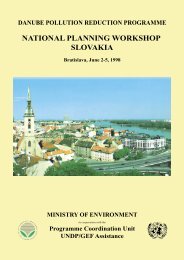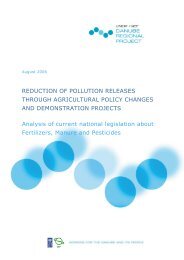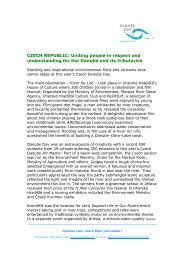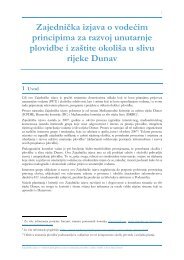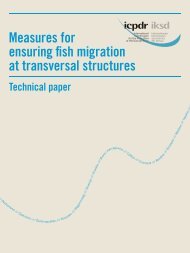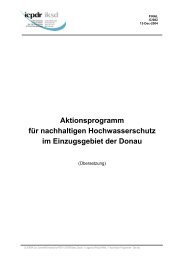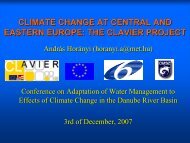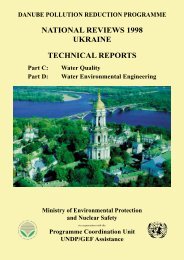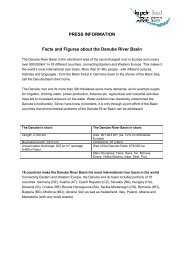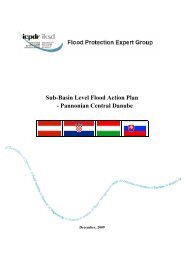You also want an ePaper? Increase the reach of your titles
YUMPU automatically turns print PDFs into web optimized ePapers that Google loves.
Addressing the threats<br />
The <strong>ICPDR</strong> is an international organisation that acts as a platform to coordinate<br />
responses to various environmental threats. Since 2009, the Danube River Management<br />
Plan (DRBM) provides a roadmap for this. It contains a Joint Programme of Measures<br />
and aims to fulfil the EU Water Framework Directive (WFD). The <strong>ICPDR</strong> also implements<br />
the EU Flood Directive (EFD) and plays a key-role in the EU Danube Strategy.<br />
Pollution Reduction<br />
The contracting parties of the <strong>ICPDR</strong> have developed best agricultural and industrial<br />
practices. These include the appropriate use of agrochemicals, proper storage of manure,<br />
or effective irrigation. Wastewaters from households are subject to important measures:<br />
wastewater treatment plants are modernised and for years, the <strong>ICPDR</strong> has worked<br />
towards limiting phosphates in detergents. This was recently taken into consideration for<br />
EU legislation. Ongoing assessments of water quality are done through the TNMN<br />
(Transnational Monitoring Network), which is coordinated by the <strong>ICPDR</strong>.<br />
Flood Protection<br />
In response to the danger of flooding, the <strong>ICPDR</strong> adopted the Action Programme on<br />
Sustainable Flood Protection in 2004. The goal of this program is to achieve a long-term<br />
and sustainable approach for managing the risks of flooding to protect human life and<br />
property, while encouraging conservation and improvement of water-related ecosystems.<br />
River Restoration<br />
The natural course of the rivers in the Danube River Basin was altered for centuries,<br />
mainly for agriculture, hydropower generation, flood defence, and navigation.<br />
Hydromorphological alterations such as river interruptions, the disconnection of<br />
wetlands, or water abstraction can provoke changes in the natural structure of rivers.<br />
As a response, the <strong>ICPDR</strong> has started initiatives that include the restoration of river<br />
continuity, the establishment of green corridors, and the construction of fish migration<br />
aids. In addition, the <strong>ICPDR</strong> engages in an active dialogue with representatives from the<br />
hydropower, flood protection and navigation sector to work towards the restoration of a<br />
natural river morphology.<br />
Public Participation<br />
Taking views from the public into consideration for water management is vital for<br />
balancing environmental, economic and social needs in the protection of the Danube<br />
River Basin. The WFD requires that countries encourage the active involvement of<br />
interested parties in decision making. Public participation is therefore a key principle<br />
of the <strong>ICPDR</strong>. On a formal level, observers have the right to participate at all <strong>ICPDR</strong><br />
decision-making meetings.<br />
24



